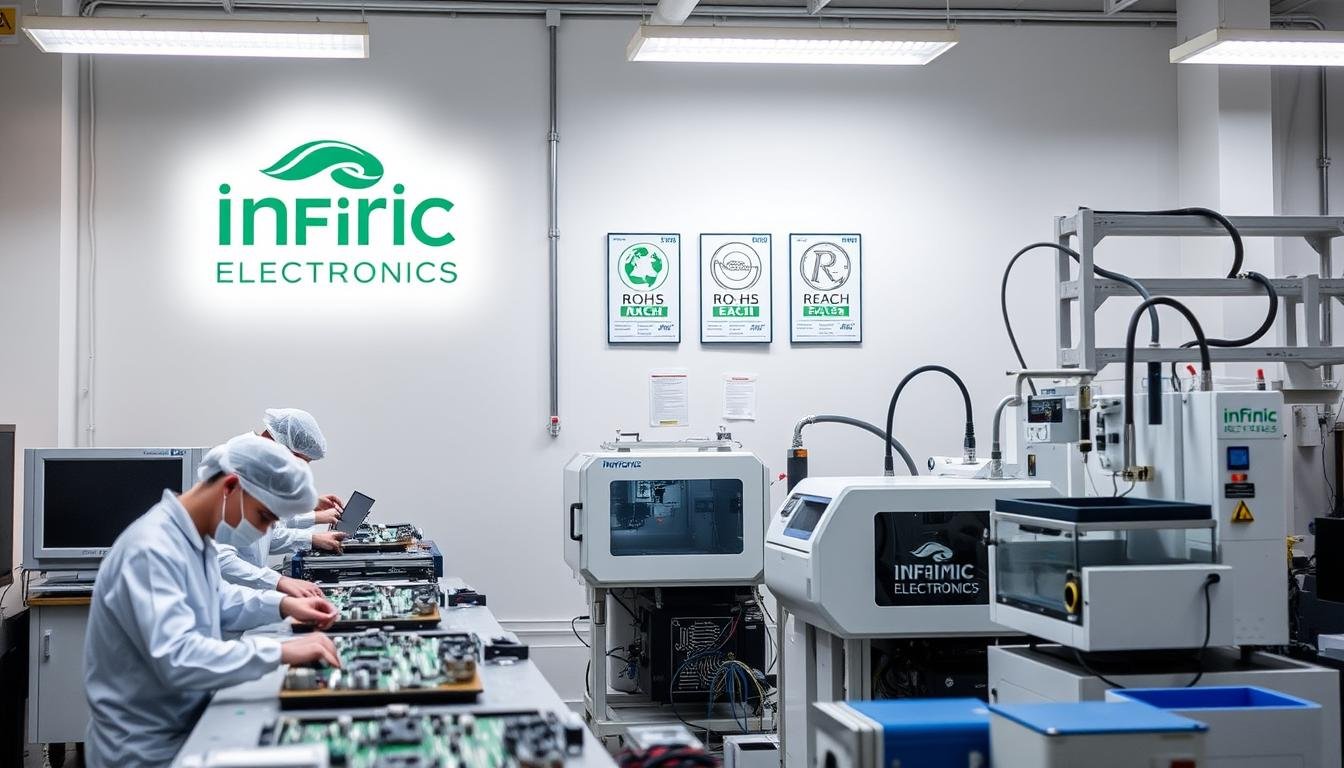What if achieving environmental compliance in electronics production could accelerate your market success rather than slow it down? As global regulations tighten, companies face a critical dilemma: balancing sustainability mandates with competitive production timelines. The stakes have never been higher since the 2019 RoHS 3 updates and expanding REACH substance lists reshaped material requirements for circuit boards, batteries, and packaging.
We’ve seen firsthand how evolving rules impact every stage of product development. Restricted chemicals now appear in 72% of standard electronic components, according to recent industry audits. This creates urgent challenges for businesses targeting markets like the EU or North America.
Our approach transforms compliance from a bottleneck into a strategic advantage. By integrating regulatory expertise during design phases, we help clients avoid costly redesigns and component substitutions. Proactive planning reduces supply chain disruptions while maintaining cost efficiency – a balance few manufacturers achieve independently.
Key Takeaways
- Global markets demand strict adherence to updated environmental standards
- Early collaboration prevents production delays and non-compliance risks
- Technical expertise spans material analysis and process optimization
- Regulatory changes require continuous monitoring and adaptation
- Documented processes ensure audit-ready supply chain management
Understanding RoHS and REACH Regulations
Navigating environmental standards requires clarity on their distinct purposes and applications. Two critical frameworks govern material safety: one targeting specific product categories, the other spanning all manufactured goods. These rules reshape how companies source components and document chemical content.
Key Differences and Similarities
| Regulation | Scope | Substance Limits | Primary Focus |
|---|---|---|---|
| RoHS | Electrical/electronic products | 0.1% (1000 ppm) for most restricted materials | Material composition in final products |
| REACH | All consumer goods | No fixed limits – risk-based restrictions | Chemical disclosure & lifecycle management |
We guide manufacturers through these contrasting requirements. The lead-free directive concentrates on homogeneous materials within finished devices. Its updated lists now include four plastic-softening chemicals beyond original heavy metal bans.
Regulation Impact on Health and Environment
Both frameworks address risks from toxic elements in production cycles. Restricted compounds like hexavalent chromium can cause respiratory issues during PCB assembly. Phthalate limits prevent groundwater contamination when devices reach landfills.
Our teams prioritize worker safety through compliant soldering techniques and ventilation systems. Proper documentation helps clients demonstrate responsible practices to regulators and eco-conscious buyers alike.
Overview of PCBA Manufacturing and Environmental Compliance
Behind every circuit board lies a web of material interactions that could derail compliance efforts if unchecked. Modern electronics production demands meticulous tracking of substances across components, from conductive inks to insulation layers. Recent studies show 90% of standard FR4 substrates contain PFAS chemicals – a reality requiring proactive mitigation strategies.
Navigating Regulatory Requirements
We address three core challenges in compliant production systems:
| Component | Compliance Focus | Common Risks | Mitigation Strategy |
|---|---|---|---|
| PCB Substrates | PFAS in epoxy resins | Non-recyclable waste | Alternative laminate materials |
| Wire Harnesses | Phthalate-free insulation | Supply chain substitutions | Supplier certification programs |
| Batteries | Heavy metal content | Disposal regulations | Lifecycle documentation |
Our teams implement cross-functional workflows combining design insights with procurement data. Real-time material databases track restricted substances across 200+ component categories. This prevents last-minute redesigns when sourcing alternate parts.
Effective compliance extends beyond initial certifications. We establish continuous monitoring protocols for evolving substance lists. Automated alerts flag components needing retesting when regulations change – a critical safeguard for companies targeting global markets.
RoHS and REACH Compliance in PCBA Manufacturing

Successful regulatory adherence demands synchronized efforts across design and production teams. Designers specify component requirements while manufacturers verify material safety – a partnership preventing costly oversights. Clear role definitions eliminate gray areas during PCB fabrication and assembly stages.
- Component databases tracking 15,000+ parts for restricted substances
- X-ray fluorescence testing for incoming materials
- Process controls maintaining optimal soldering temperatures
Surface finishes like immersion silver or organic coatings replace traditional lead-based options. These alternatives meet strict substance limits without compromising conductivity. Our teams validate each material through third-party lab analysis before production begins.
Supplier partnerships undergo rigorous audits to ensure chemical disclosures align with current standards. Automated documentation systems capture every compliance checkpoint – from solder paste certifications to final inspection records. This creates audit-ready trails that withstand regulatory scrutiny.
Technical consultations bridge design intent with manufacturing realities. We help engineers select future-proof components that adapt to evolving substance lists. Proactive planning reduces redesign cycles by 40% in our client projects, according to internal quality metrics.
Impact of Restricted Substances on PCB Design and Assembly

Modern electronics face a paradox: materials that enhance performance often carry environmental risks. Our teams navigate this complexity by balancing technical requirements with evolving safety standards.
Role of Hazardous Substances in Electronics
Historically, lead-based solders provided unmatched conductivity and low melting points. Hexavalent chromium coatings prevented corrosion in harsh environments. These solutions now require careful replacement strategies to maintain reliability while eliminating toxic elements.
Higher reflow temperatures (240-260°C) in lead-free processes test component durability. We address thermal stress through material upgrades and revised layout designs. Glass transition temperatures in substrates become critical factors during thermal cycling.
Material Considerations and Product Safety
Alternative coatings must match PFAS performance without environmental persistence. Our engineers test silicone-based conformal coatings that resist moisture without groundwater contamination risks.
Material substitutions undergo rigorous validation:
- Electrical conductivity benchmarks
- Mechanical stress simulations
- Long-term environmental exposure tests
We prevent regrettable substitutions by analyzing replacement chemicals’ full lifecycle impacts. This approach ensures new materials don’t introduce hidden health hazards or disposal challenges.
Strategies for Ensuring Compliance in PCB Manufacturing
Building reliable electronics requires more than technical skill—it demands rigorous adherence to global safety standards. We deploy three core methods to maintain regulatory alignment while preserving product performance.
Lead-Free Soldering Techniques
Modern soldering processes use SAC305 alloys that withstand higher temperatures (240-260°C). Our engineers optimize conveyor speeds and cooling rates to prevent thermal stress on sensitive parts.
| Parameter | Traditional | Lead-Free |
|---|---|---|
| Peak Temperature | 210-220°C | 240-260°C |
| Cooling Rate | 3°C/sec | 4-6°C/sec |
| Joint Strength | 35 MPa | 42 MPa |
Compliant Surface Finishes and Material Selection
We match surface treatments to application needs:
- OSP coatings for budget-conscious projects
- ENIG finishes for complex layouts
- Immersion silver for high-frequency boards
Material teams verify glass transition temperatures to ensure stability during lead-free assembly. This prevents warping in multi-layer designs.
Effective Component Sourcing and Testing
Our four-stage verification process eliminates non-compliant parts:
- Supplier certification audits
- XRF screening of incoming materials
- Batch testing documentation
- Third-party lab validation
When choosing production partners, prioritize facilities with integrated testing labs. This reduces lead times while maintaining quality control across supply chains.
Choosing the Right Manufacturer for Sustainable PCBA Production
Strategic partnerships determine success in sustainable electronics development. The best production outcomes emerge when designers and fabricators align goals before prototyping begins. This proactive approach prevents last-minute material substitutions that delay timelines.
Collaborating Early with Industry Experts
We bridge design intent with manufacturing reality through joint development sessions. Our engineers review schematics during initial phases, flagging components with potential supply chain risks. This method reduces assembly errors by 28% compared to traditional handoff models.
State-of-the-art equipment enables precise execution of eco-conscious designs. Our reflow ovens maintain ±1.5°C accuracy for lead-free soldering, while XRF analyzers verify material composition. These tools support sustainable manufacturing processes without compromising speed.
Three pillars define our customer partnerships:
- Real-time regulatory updates through supplier dashboards
- Thermal simulation tools predicting board performance
- Quarterly compliance training for technical teams
We assume full responsibility for documentation, providing audit-ready reports on every production batch. Transparent communication keeps clients informed about material availability and regulation changes impacting their projects.
Adapting to the Changing Compliance Landscape
The next wave of environmental regulations is already on the horizon. Manufacturers must shift from reactive compliance to strategic foresight. Emerging chemical challenges demand innovative solutions that balance performance with planetary responsibility.
Understanding PFAS Concerns in Modern Manufacturing
PFAS chemicals represent a critical frontier in material safety. These 4,730 synthetic substances resist natural breakdown, accumulating in water systems and food chains. Electronics manufacturers face mounting pressure as these persistent chemicals appear in moisture-resistant coatings and industrial lubricants.
We help clients transition to safer alternatives without sacrificing product reliability. Our teams validate silicone-based barriers that match PFAS performance while meeting evolving substance restrictions.
Preparing for Future Regulatory Updates
Staying ahead requires more than tracking current requirements. Our intelligence systems monitor proposed changes to global standards, including potential additions to restricted chemical lists. Early alerts give designers time to test alternative materials before mandates take effect.
Three proactive strategies safeguard production continuity:
- Quarterly supplier audits for emerging substance disclosures
- Material libraries with pre-approved alternatives
- Cross-functional teams analyzing regulation drafts
This forward-looking approach transforms compliance from a cost center into market leadership. By anticipating shifts in environmental policies, we help companies future-proof their operations while protecting ecosystems.
FAQ
How do RoHS and REACH differ in regulating electronics production?
Why is lead-free soldering critical for modern circuit boards?
What material substitutions prevent non-compliance in PCB design?
How do PFAS concerns affect component sourcing strategies?
What certifications should a compliant PCBA partner provide?
Can outdated surface finishes jeopardize product compliance?
How frequently should compliance testing occur during assembly?
What design risks arise from non-compliant components?
How are EU regulations shaping global electronics standards?
What documentation proves compliance during customer audits?
About The Author
Elena Tang
Hi, I’m Elena Tang, founder of ESPCBA. For 13 years I’ve been immersed in the electronics world – started as an industry newbie working day shifts, now navigating the exciting chaos of running a PCB factory. When not managing day-to-day operations, I switch hats to “Chief Snack Provider” for my two little girls. Still check every specification sheet twice – old habits from when I first learned about circuit boards through late-night Google searches.
